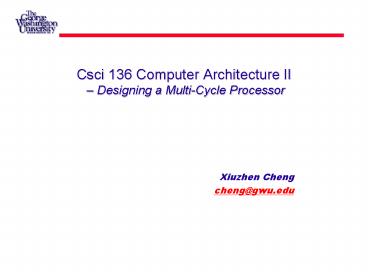Csci 136 Computer Architecture II - PowerPoint PPT Presentation
Title:
Csci 136 Computer Architecture II
Description:
Csci 136 Computer Architecture II Designing a Multi-Cycle Processor Xiuzhen Cheng cheng_at_gwu.edu – PowerPoint PPT presentation
Number of Views:81
Avg rating:3.0/5.0
Title: Csci 136 Computer Architecture II
1
Csci 136 Computer Architecture II Designing a
Multi-Cycle Processor
- Xiuzhen Cheng
- cheng_at_gwu.edu
2
Announcement
- Homework assignment 8, Due time before class,
March 29. - Readings Sections 5.5-5.6
- Problems 5.32, 5.33, 5.36.
- Quiz 3 March 29
- Project 3 is on-line
3
Review on Single Cycle Datapath
- Subset of the core MIPS ISA
- Arithmetic/Logic instructions AND, OR, ADD, SUB,
SLT - Data Flow instructions LW, SW
- Branch instructions BEQ, J
- Five steps in processor design
- Analyze the instruction
- Determine the datapath components
- Assembly the components
- Determine the control
- Design the control unit
4
The Complete Single Cycle Datapath
How lw, sw, R-Type, beq, j instructions work? Why
the design of AUL control takes two levels?
5
Delays in Single Cycle Datapath
What are the delays for lw, sw, R-Type, beq, j
instructions?
6
Remarks on Single Cycle Datapath
- Single Cycle Datapath ensures the execution of
any instruction within one clock cycle - Functional units must be duplicated if used
multiple times by one instruction. E.g.
ALU. Why? - Functional units can be shared if used by
different instructions - Single cycle datapath is not efficient in time
- Clock Cycle time is determined by the instruction
taking the longest time. Eg. lw in MIPS - Variable clock cycle time is too complicated.
- Multiple clock cycles per instruction this
lecture - Pipelining Chap 6
7
Multiple Cycle Datapath
- Minimizes Hardware 1 memory for data and
instruction, 1 ALU - A functional unit can used more than once as long
as it is used on different clock cycles - Advantages shared functional units, different
cycles for different instructions, short clock
cycles - Assumptions each clock cycle can accommodate at
most one of the following operations a memory
access, a register file access, or an ALU - Temporary registers A, B, IR, MDR, ALUOut
- A high level view of the multi-cycle datapath
8
Multiple Cycle Datapath with Control
9
Supporting Jump and Conditional Branch
- Need PC control
- PC is updated conditionally for branch and
unconditionally for normal increment and jumps - Control unit generates PCWrite and PCWriteCond
based on op code of the instruction - For branch, PCWriteCond and Zero must be set
- For Jump or other unconditional PC update,
PCWrite must be set - Thus PCControl (PCWriteCond and Zero) or
PCWrite - PC source selection
- A mux with 3 inputs PC4, PC
signExt(IR15-0)ltlt2), PC31-28 (IR25-0ltlt2)
10
The Complete Multicycle Dataath
11
Breaking Instruction Execution into Multiple
Cycles
- Instruction Fetch
- IR MemoryPC PC PC4
- Instruction Decode/Register Fetch
- A RegIR25-21 B RegIR20-16 ALUOut
PC (sign-extend(IR15-0)ltlt2) - Execution, Address compuation, branch/jump
completion - R-type ALUOut A op B
- Memory access ALUOut A sign-extend(IR15-0)
- Branch if (AB) then PC ALUOut
- Jump PC PC31-28 (IR25-0ltlt2)
- Memory Access or R-type Completion
- R-type RegIR15-11 ALUOut
- Load MDR MemoryALUOut orStore MemoryALUOut
B - Memory read completion
- Load RegIR20-16 MDR
12
Defining the Control
- The control of the multicycle datapath must
specify both the signals to be set in any step
and the next step in the sequence - Two techniques
- Finite state machine
- Each state (a circle) contains the valid control
signals - Directional links point to next state
- Each cycle corresponds to one state
- FSM is the graphical representation of the
control - Microprogramming
- Assume the set of control signals that must be
asserted in a state as an instruction to be
executed by the datapath - Microprogram is a symbolic representation of the
control that will be translated by a program to
control logic
13
The high-level view of the FSM control
start
Instruction fetch / decode and register fetch
Memory accessinstructions
R-typeinstructions
Branchinstruction
Jumpinstruction
14
Finite State Machine Control
Figure 5.42
15
Implementation of the FSM Control
Figure 5.37
16
In-Class Exercise
- How to modify the complete datapath (Figure 5.33)
for the multiple cycle implementation to
accommodate the ori (or immediate) instruction?
Given the FSM control design - What about addi, jal and jr instructions?
17
Exception Handling (1/6)
- Exception vs. Interrupt both are unexpected
events in control flow - Interrupt externally caused events
- Exception internally caused events
- Consider two types of exceptions in our current
implementation - Arithmetic overflow
- Undefined instructions
- How exceptions are handled?
- Save the address of the offending instruction to
EPC. How to find out the address of the offending
instruction? - Transfer control to the OS at some specified
address. How? - May transfer control back through EPC
18
Exception Handling (2/6)
- Cause register a status register to record the
reason of the exception - One single entry point for all exceptions can be
used. - Vectored interrupt
- Control will be transferred based on the cause of
the exception - Eg Exception Type Exception Vector Address
undefined instruction C000 0000 arithmetic
overflow C000 0020
example
19
Exception Handling (3/6)
- EPCWrite and CauseWrite
- IntCause
- The LSB of the cause register to hold the state
- 0 for undefined instruction
- 1 for arithmetic overflow
- IntCause will be used to set the LSB of the Cause
register - exception address 8000 0180
- The entry point for exceptions
- Question How to modify the current datapath for
exception handling?
20
Exception Handling (4/6)
21
Exception Handling (5/6)
22
Exception Handling (6/6)
23
Questions?































